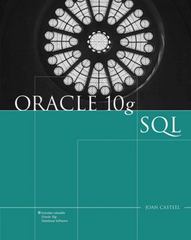Question
ANSWER WITH MATLAB CODE Write a function getcodonusage(s) that takes a DNA strand s as input, calls the findorf(s) function to find the ORF, and
ANSWER WITH MATLAB CODE
Write a function getcodonusage(s) that takes a DNA strand s as input, calls the findorf(s) function to find the ORF, and returns the codon usage of the sequence as both a vector (each element corresponding to the count of a codon, where codons are in alphabetical order) and as a struct with each codon as a field, and its count as the number of occurence of that codon. The returned structure should contain all possible codons, with codons not occurring in the sequence having a count of 0. Do not use functions available in the Bioinformatics toolbox. Hint: You may find getallcodons.m function useful. If your solution calls other files (such as findorf and getallcodons), you can add these functions to the end of your getcodonusage.m file, so your getcodonusage file is self-contained.
Here is an outline (pseudocode) for this function that you can follow. This is of course, not exactly the Matlab code.
Let v be the codon count vector. Let r be the codon count struct. allcodons=getallcodons(); Initialize v to be a vector of zeros (you will have as many elements as allcodons). Foreach allcodons as cod: Initialize r.(cod) to zero. orf=findorf(s); Foreach orf as cod: Find the index of cod in allcodons using strcmp(). Increment the corresponding entry in v by one. Increment r.(cod) by one.
The following are codes for findorf.m and getallcodons.m, please use them in your answer!:
function cods = getallcodons
for i='ACGT'
for j='ACGT'
for k = 'ACGT'
cods(end+1) = [i j k];
end
end
end
function o = findorf(s)
s='ATTAATGCATTTTTAGGAATA';
starts = strfind(s,'ATG');
stops = [strfind(s,'TAA') strfind(s,'TAG') strfind(s,'TGA')];
if isempty(starts); starts=1;
orfs = zeros(0,2);
for mystart=starts
I = (stops > mystart) & (mod(stops - mystart, 3)==0);
mystops = stops(I);
if isempty(mystops); mystops= numel(s); end
mystop = mystops(1);
orfs(end+1,:) = [mystart mystop];
end
lengths = orfs(:,2) - orfs(:,1);
[maxlen, I] = max(lengths);
startstop = orfs(I,:);
o = ();
for i =startstop(1) : 3 : startstop(2)
o[end+1] = s(i:i+2);
end
Step by Step Solution
There are 3 Steps involved in it
Step: 1

Get Instant Access to Expert-Tailored Solutions
See step-by-step solutions with expert insights and AI powered tools for academic success
Step: 2

Step: 3

Ace Your Homework with AI
Get the answers you need in no time with our AI-driven, step-by-step assistance
Get Started


